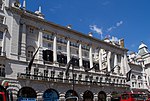Simpsons of Piccadilly
1936 establishments in EnglandArt Deco architecture in LondonBookshops in LondonBritish Royal Warrant holdersBritish companies established in 1936 ... and 11 more
Buildings and structures on PiccadillyCompanies based in the City of WestminsterDefunct department stores of the United KingdomGrade II* listed buildings in the City of WestminsterGrade II* listed retail buildingsReal estate companies established in 1936Retail buildings in LondonRetail companies established in 1936Shops in LondonTourist attractions in the City of WestminsterUse British English from March 2017

Simpsons of Piccadilly was a large retail store situated at 203-206 Piccadilly in central London. It was created by Alexander Simpson and architect Joseph Emberton. When it opened in April 1936 it was the largest menswear store in Britain, and is now a Grade I listed building due to its innovative construction. Its original purpose was to house the entire range of clothing provided by the tailoring company S. Simpsons and DAKS. It was later purchased by the Waterstones chain of bookshops, and currently serves as their flagship store.
Excerpt from the Wikipedia article Simpsons of Piccadilly (License: CC BY-SA 3.0, Authors, Images).Simpsons of Piccadilly
Piccadilly, City of Westminster Mayfair
Geographical coordinates (GPS) Address Website External links Nearby Places Show on map
Geographical coordinates (GPS)
| Latitude | Longitude |
|---|---|
| N 51.5092 ° | E -0.1361 ° |
Address
Waterstones
Piccadilly 203-206
W1J 9HD City of Westminster, Mayfair
England, United Kingdom
Open on Google Maps









